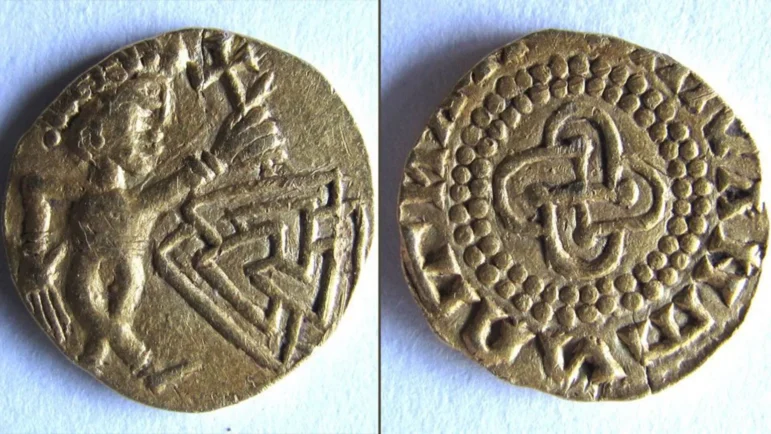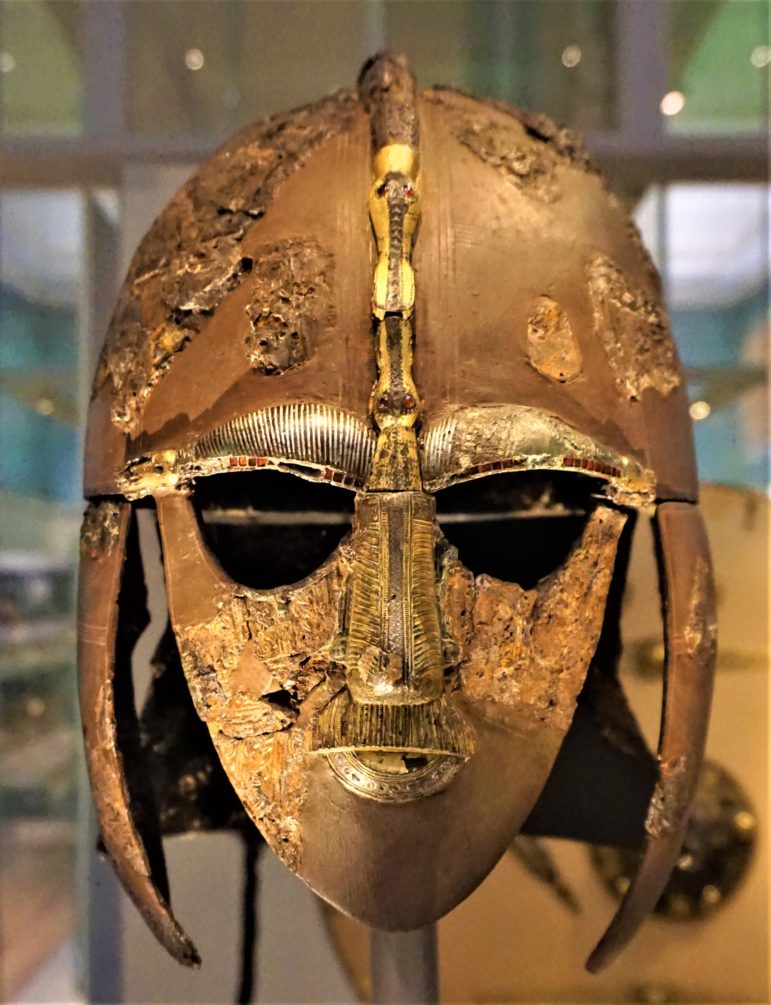
Uncovering the Past
LONDON – A rare and unusually designed gold coin, dating from the 7th century CE, has been unearthed in East Anglia, offering a remarkable window into the complex religious shifts of early medieval Britain. Discovered by a metal detectorist in the autumn of 2024, the tiny coin—roughly the size of a fingernail—is rich in symbolism, blending Christian and Pagan iconography in ways never before seen.
Struck between 640 and 660 CE, the coin features a diademed figure—likely representing a Christian emperor—holding a long cross. Below the figure lies the valknut, a symbol associated with the Norse god Odin. On the reverse is a second enigmatic design that scholars believe could either be a cross or a swastika. The coin’s high gold content aligns with the practices of early Anglo-Saxon coinage, though the iconography is unprecedented.

The 7th- Century coin found by a metal detectorist [Photo Credit: Dr. Adrian Marsden / Courtesy
Dr. Marsden, from the Norfolk Historic Environment Service, spoke with the press about the coin. “It’s the first one of this type of coin that we’ve see,n and new types of shillings just don’t turn up,” Madsen said. “It’s got this fascinating iconography of a little figure with a long cross – explicitly Christian – over the valknut design, which has pagan roots.”
He goes on to say that the valknut (a modern term meaning ‘knot of those fallen in battle’) is ‘uncompromisingly Pagan.’ It appears on two contemporary stones found in Gotland in Sweden, on a ring found in the river Nene, and on a bedpost in the 9th-century Oseberg ship burial – but despite the modern terminology, we’re not sure exactly what the valknut represents.
The coin may represent the oldest Anglo-Saxon coin discovered to date and appears contemporary with the famed Sutton Hoo ship burial, an iconic site marking the transition from Pagan to Christian practices in Anglo-Saxon England. Although the coin is of an unknown type, some experts suggest it may be a precursor to the East Anglian “Trophy type” coin series.
Marsden believes it may be emblematic of a time in which Christianity was gradually overtaking Pagan customs in Anglo-Saxon Britain. It is believed that although the coin is of a type that has not been seen before, it could be a forebear to the more well-known East Anglian Trophy type series.
“We’re clearly looking at a coin struck at a turning point,” Marsden observed, pointing to the co-existence of spiritual systems reflected in its imagery.
The coin bears Latin letters, although they’re jumbled up and, as far as experts can tell, meaningless. However, other coins of this Trophy type are inscribed with runes – although Marsden points out that the use of runes persisted well past the end of the Pagan period in Britain, and also notes that the runes on these coins appear to be as meaningless as the Latin inscriptions! He suggests that there was a feeling that coins ought to have letters on them, whether they meant anything or not.
Do we know who this coin might have belonged to?
The finder of the coin believes that it was owned by Sigebehrt, one of the East Anglian kings who came to power around 629 CE. He didn’t remain in power for long, abdicating in 634 to become a monk. He was removed from the monastery in order to lead an army against the invading Mercians, but refused to take up arms and was killed during the subsequent battle. Marsden is cautious about this attribution, noting the lack of identifying inscription and arguing that Sigebehrt was likely too devout a Christian to have authorized coinage containing overt Pagan symbols—even if the Pagan imagery is subordinated beneath Christian ones.

Sutton Hoo helmet – Image credit: Joyofmuseums – CC BY-SA 4.0, https://commons.wikimedia.org/w/index.php?curid=71020963
This coin adds to a growing collection of Anglo-Saxon and Roman-era hoards being discovered in Norfolk. Between 2014 and 2020, another significant hoard of 129 coins—found in a field in East Anglia—was acquired by the Norwich Castle Museum and Art Gallery. The hoard includes 118 unique coin designs from 51 European mints, including Frankish tremisses from the Merovingian kingdoms (modern-day France, Germany, Switzerland, and the Low Countries). These Frankish coins, minted shortly after the fall of the Roman Empire, may slightly predate Anglo-Saxon coinage—though the newly found coin could prompt revisions in dating.
Curator of archaeology Dr Tim Pestell told the BBC: “This internationally significant find reflects the wealth and continental connections enjoyed by the early Kingdom of East Anglia. Study of the hoard and its find spot has the potential to unlock our understanding of early trade and exchange systems and the importance of west Norfolk to East Anglia’s ruling kings in the 7th Century.”
East Anglia is proving a valuable hunting ground as regards coins: 16 silver Roman coins were discovered in Norfolk in March of this year and are now the subject of a treasure inquest; the earliest of these coins was hundreds of years old when the hoard was concealed or lost, dating from 57 BCE. Dr Marsden has also evaluated this hoard, commenting that
Commenting on the Roman hoard, Dr. Marsden noted that the region around King’s Lynn, on the edge of the Fens, was historically prosperous. “There was a line of villas here and you’ve got [the county’s longest Roman road] the Peddars Way—because the soil is very fertile and it’s prime agricultural land,” he said. “While it’s always very difficult to tie in coins with prices today… the loss was probably worth the equivalent of a few hundred quid to its owner.”
This latest find is yet another reminder that East Anglia’s fields may still hold critical insights into the religious, economic, and cultural crossroads of early medieval Britain.
The Wild Hunt is not responsible for links to external content.
To join a conversation on this post:
Visit our The Wild Hunt subreddit! Point your favorite browser to https://www.reddit.com/r/The_Wild_Hunt_News/, then click “JOIN”. Make sure to click the bell, too, to be notified of new articles posted to our subreddit.